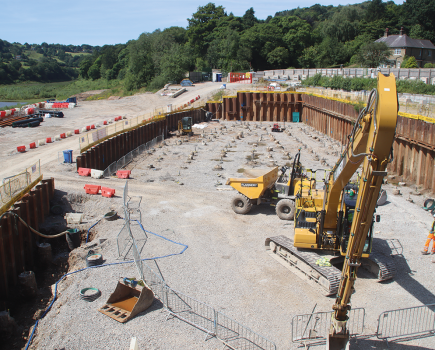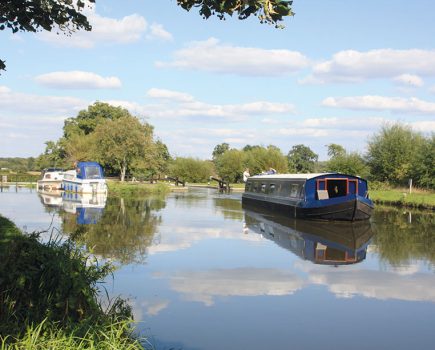A dead-end waterway with no locks and just the odd short tunnel and aqueduct, the Ashby Canal is nonetheless well worth a visit for the many miles of quiet midland scenery, and some interesting sites to visit

The 22 mile long Ashby-de-la-Zouch Canal (to use its seldom-heard full name) has no locks at all. This makes it a stress-free cruise for inexperienced boaters and a leisurely journey for regular boaters needing a rest from endless flights of locks – with the added attraction that the waterway is almost entirely rural.
Despite its rural appearance, it was a busy coal-carrying canal in its day, its terminus near the village of Moira being surrounded by coalfields (The name is a misnomer as the canal never reached Ashby-de-la-Zouch). Working boatmen, who called it ‘The Moira Cut’, carried coal from around Moira for many years. However, the trade which had brought success to the waterway eventually became its downfall, when mining subsidence caused the successive closure of its northern eight miles from 1944 onwards, leaving just the 22 miles from Marston Junction to just north of Snarestone.
After the Second World War, boats from Gopsall Wharf continued carrying coal to customers including Croxley paper mills and Coventry power station. This traffic ended in 1970 and since then the surviving length of the canal has become a popular pleasure cruising waterway. Recently the canal’s northern limit has been extended via a rebuilt bridge to about half a mile beyond Snarestone, the first stage in ambitious plans to restore it back to Moira.

Apart from a short tunnel at Snarestone and a small aqueduct at Shenton, the canal lacks major architectural features – but it makes up for this with the splendid countryside and the nearby attractions of the Bosworth Battlefield site and the steam railway. At times the canal can be shallow in depth and bank vegetation growth is often high in late summer – so just take it gently and enjoy this quiet rural route.
The canal starts at Marston Junction, which is just to the north of Bedworth, where it leaves the Coventry Canal, passing through the remains of a former water-control stop lock and heads off into the countryside. Incidentally, the old stop lock was built to take standard 7ft wide narrowboats, but the rest of the canal was built to broader standards, a reminder that the original intention was to connect with the wide-beam eastern section of the Trent & Mersey Canal near Burton upon Trent.
Industry and housing estates are soon replaced by fields and woodland as the canal approaches Burton Hastings village, which is set on a hill and can be reached from Bridge 8. Two miles of peaceful open countryside follow leading to the Lime Kilns pub. This former coaching inn once also provided stables for the working boatman’s horses, and now it is a welcome stop for both boaters and those on the busy A5 trunk road.

The canal now passes through the western fringes of Hinckley, surrounded by housing and some industry. Hinckley Wharf is now used for boat club moorings and a little further on, Trinity Marina provides all boaters’ facilities plus a shop, pub, restaurant and an adjacent hotel.
Leaving the town behind, there are another three miles of open countryside with the occasional bridge before reaching Stoke Golding, which to those arriving by road proudly proclaims itself ‘The Birthplace of the Tudor Dynasty’. No such pronouncements on the canal, but there is a boatyard with a hire-fleet and a marina known as the Ashby Canal Centre. Stoke Golding village is a short walk from the canal, with a useful farm shop, post office and pubs.
The canal bends towards Dadlington but then shies away avoiding the village entirely before resuming its northerly course to Sutton Cheney Wharf. Here, suddenly after the quiet rural lengths, there is plenty of activity with trip boats, a waterside cafe and a car park full of coach parties. Boaters can moor up and walk to the Battle of Bosworth site, or carry on to moorings at Bridge 35 at Shenton known as King Richard’s Field and follow the marked trail.

The Bosworth Battlefield Heritage Centre and Country Park is a must for visiting boaters (see inset), and on a fine day a walk along the battlefield trails over hills and woodland is memorable. But after all the descriptions of King Richard’s gory demise including Shakespeare’s offer of his kingdom for a horse, it comes as some relief to return to the tranquillity of the Ashby Canal.
Shenton Aqueduct spans a minor road close to the station where you can take a steam train on the Battlefield Line from Shenton to Shackerstone (see inset). If you are feeling energetic on a nice day, consider a single journey on the train, returning by a five mile walk along the towpath from Shackerstone. For those boaters preferring more leisurely pursuits, stop for a while at the beautifully situated picnic site by Bridge 37 where there are moorings.
The canal continues northwards towards Market Bosworth but keeps to the western edge of the town. The centre of the town with all its shops, banks, post office, pubs and an excellent fish and chip shop are about a mile walk from Bridge 42. Boaters may wish to stock up with provisions, as there is little chance of finding anything substantial between here and the end of the waterway.

A 50 acre leisure park with large lakes for fishing, sailing and water sports can also be reached from Bridge 42 in the opposite direction from the town, and a new marina has opened not far north of the bridge.
In the next three miles the canal leaves civilisation behind as it winds through remote countryside. The isolated village of Congerstone can be discovered west of Bridge 47, and you may hear the odd whistle from a steam train on the nearby railway, but otherwise this is a very peaceful section of canal.

The railway becomes more evident as you reach Shackerstone which marks the end of the Battlefield Line, and the site of the railway museum, tea room, and headquarters of the railway society which operates the line
The canal leaves Shackerstone over a small aqueduct, and there then follows another two miles through lovely wooded countryside to Gopsall Wharf. From there it is just a short journey to Snarestone where the canal’s only tunnel has a pub above it. Two stone-arched bridges lead to where the canal used to end; but now a recently restored bridge continues the route for another quarter mile or so. There isn’t much to see at the temporary terminus, but you can moor up and walk for a mile and half to Measham. If you’re feeling energetic, you can explore more of these disused northern reaches of the canal.

The canal once continued eight miles through Measham to Moira, until mining subsidence resulted in its closure. But already an isolated length at Moira has been restored, and there are ambitious plans to link up to this, although diversions will be needed where the original line has been obliterated.
The restored section hosts the annual Moira Canal Festival, which features the Moira Furnace Museum (see inset) and Conkers (the National Forest Discovery Centre).

If you want to get an idea of what the canal will look like when restoration is complete and the northern reaches are busy with boats, visit during the annual Moira Festival, when the restored length sees many visiting trail boats attending. This year’s event also hosts the Inland Waterways Association’s National Trailboat Festival, and takes place around Moira Furnace during the May bank holiday weekend on May 27-28.
Beyond the Furnace, a new lock was built in 2001 allowing access to a newly rebuilt section of canal terminating at Conkers and the National Forest Centre. Moira Lock therefore has the distinction of being the first lock ever built on the Ashby Canal. Conkers is an adventure centre for families with children. The 120 acre site has lots of outdoor and indoor activities including the ‘Enchanted Forest’ and a Waterside Centre.
Hopefully, one day this will be a popular terminus for the completely restored and reopened Ashby Canal.

The Battlefield Line is a steam railway whose heritage trains run from Shackerstone to Shenton. At Shakerstone there is a railway museum packed with exhibits dating back to the age of steam, and a locomotive shed where you can see the steam engines that are not in use or being restored.

The Bosworth Battlefield Heritage Centre and Country Park occupies the site believed to be that of the Battle of Bosworth in 1485. King Richard II was killed in what turned out to be the final battle of the Wars of the Roses, with the crown of England passing to Henry Earl of Richmond who as Henry VII became the first Tudor King. The visitor centre has all the information about the battle plus a cafe and shop, and there are battlefield trails to walk.

Moira Furnace, which was built in 1806, has been expertly preserved by English Heritage as a scheduled monument and is regarding as one of the finest examples of an early iron works building in Europe. It is now a museum about the history of the building and the story of the production of iron. There are lime kilns, woodland walks and craft workshops.

Image(s) provided by:
Derek Pratt







